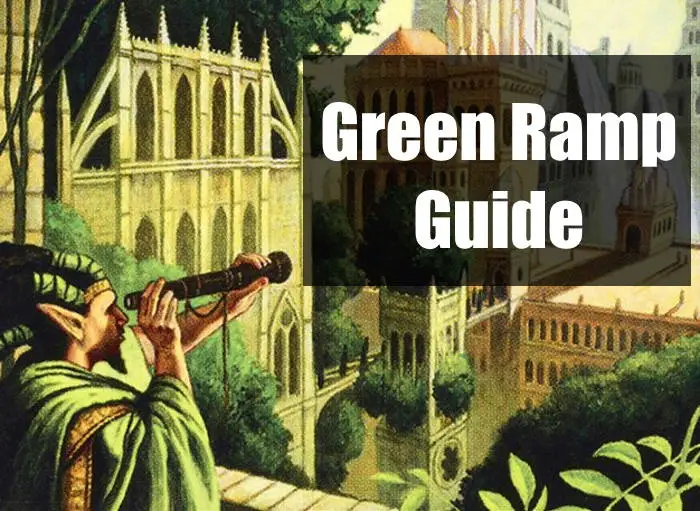When you’re building a Commander deck, it’s important to build a solid foundation to support your strategy. As an example, decks that don’t have enough ramp will fall behind their opponents, even at more casual tables. You’ll need to find ways to get extra mana, and green has the best options for ramp in the game.
Ramp refers to any effect that gives you more mana than you would normally have. Rampant Growth, for example, puts an additional land into play, which will provide extra mana for the rest of the game. That extra mana allows you to either play expensive spells sooner or play multiple spells in the same turn, which can give you a big advantage over the other players. As a result, ramp is one of the most important effects in EDH. Some ramp spells are better than others, but there are sure to be some that can synergize with your deck.
While it’s easy enough to include whatever ramp you happen to have, it’s worth taking a closer look at these slots. Your deck can become a well-oiled machine if its ramp synergizes with its main gameplan. To better understand how to make the most of your ramp, let’s break down why green ramp cards in particular are so strong, as well as what types of ramp you can choose between.
Why Do You Need Mana Ramp in EDH?
You might find it surprising that ramp is so important in EDH. After all, no other format sees ramp played so consistently, nor across all five colors.
In Commander, setting up your mid-to-late game is the best early play you can make. Since each player starts with 40 life instead of 20, most decks won’t have success just playing cheap creatures. Even if a player gets a strong, aggressive start, they won’t deal 40 damage to all of their opponents right away. Instead, it’s much more important to build up for the later stages of the game.
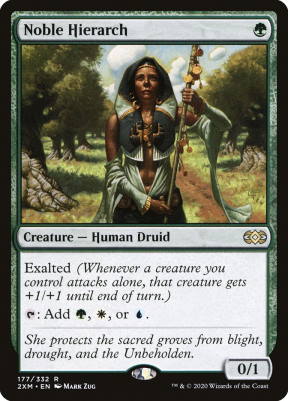
Commander games are often defined by explosive turns. A player might cast a big, expensive spell, or (as is more common nowadays) they could cast multiple high-impact spells in the same turn. Either way, having extra mana is key to pulling off these plays.
Ramp lets you cast these spells sooner, and green ramp cards specifically can usually get whatever color of mana you need. Even if it doesn’t win you the game, having more mana gives you more options. It’s often worth it to play ramp early and set yourself up for success later in the game.
How Many Ramp Cards Should You Run?
Green is spoiled for choice when it comes to ramp cards, but just how many of them should you put in your deck? If you have too much ramp, you might not draw any of the spells that you wanted to ramp into. If you have too little, you’ll fall behind the other players. So what’s the right balance?
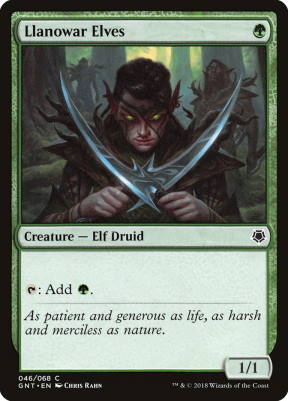
Ultimately, the right answer depends on your deck and your meta. As a general principle, though, don’t go below 8 sources of ramp. Sticking to 10-12 is a much safer number, and some decks might want even more than that. If you’re running lots of expensive cards, or you have plenty of useful mana sinks, then you could run even more. On the other hand, decks with very low curves could get away with running fewer ramp cards.
RELATED: 5 Common Commander Deck Building Mistakes
You can definitely play around with these numbers to find the right balance for your deck. In fact, optimized decks have been running more and more cheap ramp recently, so you could consider going up to 15 sources or more. It all depends on what power level and strategy you’re aiming for.
Can Creatures Count as Ramp Cards?
Yes! Green has had creatures that serve as ramp ever since Alpha. There are multiple creatures that can ramp you efficiently, such as Llannowar Elves. Getting one additional mana on each of your turns is an incredibly strong effect for a one-cost card.
The only downside is that creature removal is quite common. While it’s unlikely that your opponents would spend a card to remove your Birds of Paradise in EDH, it could happen. What’s more likely is that someone plays a board wipe and your mana dorks get caught in the crossfire. Mass removal can set you back quite a bit if your only form of ramp is creature-based.
RELATED: The Top 10 MTG Red Board Wipes
Should You Run Expensive Green Ramp MTG Cards?
It depends. In most cases, you’ll want to stick to ramp that costs two mana or less. There are some exceptions, such as Cultivate, but most decks don’t want to spend four or more mana just to ramp. Remember, one of the main strengths of ramp is that it sets you up for later in the game. At a certain point, you want to execute your gameplan rather than just acquire more resources.
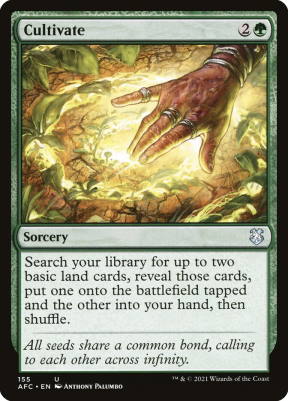
The main exception would be for decks that are incredibly mana hungry. Zaxara, the Exemplary, for example, cares about playing X spells. These get better the more mana you put into them, and you’ll need lots of mana if you want to cast more than one in a turn. In this case, it could be worth it to run expensive ramp spells since they give you even more mana.
No matter what you decide, make sure you’re still playing efficient ramp. Typically, you want your ramp to give you half of the mana you spent on it. Rampant Growth gives you one land, Skyshroud Claim gives you two, and so on.
Of course, some ramp cards have odd mana values, but these usually have some kind of additional effect. Cultivate is one of my favorite examples of this standard. Not only does it give you an extra land when you cast it, but it also ensures that you’ll keep hitting your land drops in the future. There are a variety of effects you can get from odd-costed ramp cards, so just make sure you’re getting what you paid for!
What Kinds of Green Ramp Cards Exist?
Now that we’ve gone over some of the most common questions about ramp, what are your options? There are plenty to consider, and the right ones for your deck will depend on your strategy and synergies.
Land Ramp
When Magic players think of green ramp cards, their minds often turn towards land-based ramp. It has a wide selection of cards to choose from, as well as some of the strongest synergies.
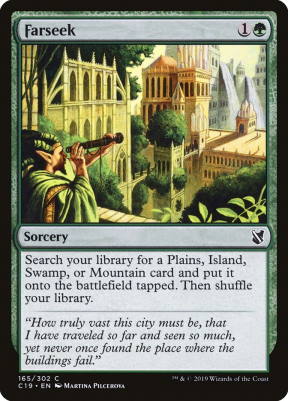
Rampant Growth, Farseek, Three Visits, and more all let you ramp on turn two. These cards also combine well with common finishers, such as Avenger of Zendikar.
Even if your deck only has a few cards that synergize with lands, such as Evolution Sage in a +1/+1 counters deck, making those cards slightly better by including land-based ramp can often be worth it. Lands are also very difficult for your opponents to interact with, so most decks can justify running these cards.
Mana Dorks
Next, we have another one of green’s specialties: mana dorks. Any creature that taps for mana can be considered a mana dork, and there are plenty of great options available.
We’ve already mentioned Birds of Paradise and Llanowar Elves. Along with these, green has plenty of mana dorks that only cost one, which is incredibly efficient. If these creatures stay on the battlefield, they can provide more value than Farseek and the like.
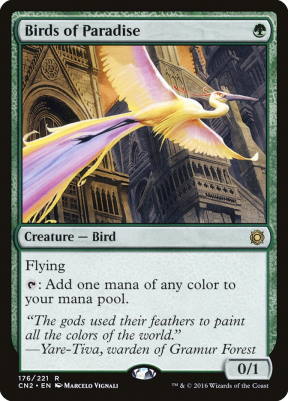
Of course, there’s no guarantee they’ll stick around.
Still, there are plenty of decks that can use mana dorks. In a token deck, Leafkin Druid will often tap for two mana instead of one. The same goes for Ilysian Caryatid in a deck with lots of big creatures. Mana dorks can also get buffed up by cards like Craterhoof Behemoth, so they can be a part of your win condition.
If a mana dork synergizes well with your deck, you should feel free to include it. Just don’t go overboard, or you’ll risk getting blown out by a well-timed sweeper.
Mana Rocks
Mana rocks are ubiquitous across every color, so this isn’t an option that’s specific to green. Green also has the least amount of synergy with artifacts compared to the other colors. Still, it’s worth mentioning that this is another common way to get extra mana.
RELATED: The Best Mana Rocks in Magic: the Gathering
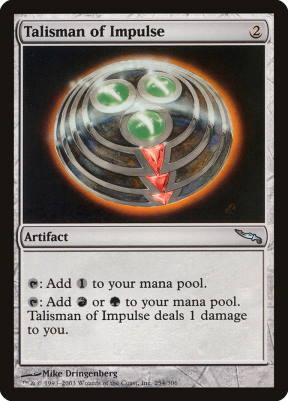
Artifacts are generally safer to play than creatures because there are fewer
Creatures that Sacrifice Themselves
There’s a subset of creatures that sacrifice themselves to get extra lands into play. These cards have lots of potential synergies, and at worst are just another way to grab more lands.
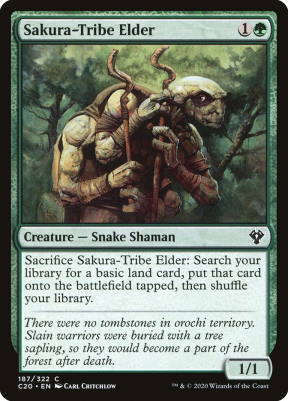
Sakura-Tribe Elder is the best in this category because its ability is free, and you can activate it at instant speed. Most other creatures with this effect will cost you three mana in total, so they’re just not as efficient. Dawntreader Elk, for instance, costs two mana to cast and one mana to activate its ability.
Other than Sakura-Tribe Elder, it’s hard to recommend these cards for optimized decks. However, these are excellent for budget decks with graveyard or sacrifice strategies. Not only do they fit your gameplan, but you can also recur them to create a strong value engine.
As an example, Meren of Clan Nel Toth might only get you cheap creatures in the early game. If you decided to recur one of these creatures, however, you could ramp even more while giving her another experience counter. By including a card that’s less efficient on its own, you’re actually setting yourself up incredibly well for the mid-to-late game. This is why choosing your ramp cards based on your deck’s strategy can give you better results than going with the most commonly used cards.
Enchantment Ramp
Green ramp cards can be just about any permanent type, and that includes enchantments. Usually, these are auras which attach themselves to your lands. Wild Growth, for example, creates additional mana whenever you tap the enchanted land. This is another way for green to ramp on turn one, but it’s also vulnerable to removal.
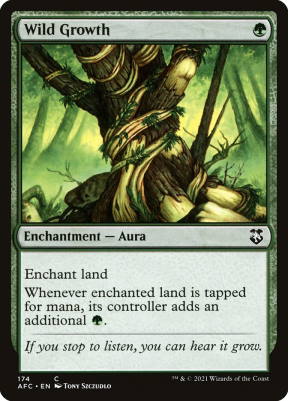
Commander players typically agree that mass land destruction is off limits, but there’s still some targeted land removal in the format. If an opponent plays Acidic Slime, for instance, they could destroy the enchanted land, and your aura would be destroyed as well. Magic players love value, and getting such a clean 2-for-1 would be tempting for a lot of your opponents.
Of course, not every deck has targeted land removal. Even if one of your opponents does have access to this effect, they’d have to choose your land over other potential threats on the table. You should just keep in mind that auras are inherently risky, and you’re opening yourself up to 2-for-1s when you play them.
Still, these cards can be powerful in the right deck. The most obvious strategy for them is anything built around enchantments. They also pair well with lands that protect themselves, like Lotus Field. Even without synergy, these auras provide ramp on turn one, and they’re still safer than playing a mana dork.
Looking for Overlap
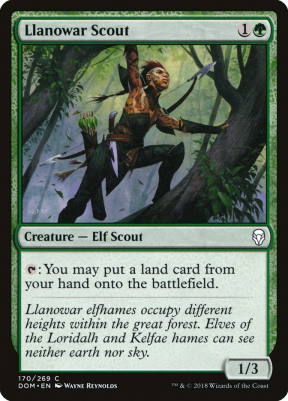
Of course, not every card fits into just one of these categories. Some creatures, like Llanowar Scout, tap to add additional lands into play. You could call it a mana dork, but it also works with land-based synergies. There are also enchantments like Cryptolith Rite that turn all your creatures into mana dorks.
To me, one of the joys of EDH is tweaking my decks so they’re just right, and analyzing my ramp is a big part of that process. After all, I want to see at least one or two ramp cards during every game, so why not get all the value I can from them?
Considering how my ramp interacts with the rest of my deck not only gives me small edges in gameplay, but it also helps me understand my deck better. I find that swapping out staples for unique, synergistic cards is incredibly satisfying, and I encourage you to take a deep dive into your ramp to see if you can do the same.
Why is Land-Based Ramp So Strong?
Without looking at potential synergies, land-based ramp is the best option available. Out of every permanent type, players are the least equipped to deal with lands. There aren’t many efficient removal spells that deal with lands, and mass land destruction is a big taboo in the format. As a result, you can be fairly certain that any lands you play will stick around for the whole game.
How Do You Beat Green Ramp Cards?
Players have been asking this question for years. Removal spells that destroy a single land are often too inefficient to play, and mass land destruction is overkill. So how are you supposed to answer green ramp cards?
There’s no easy way to beat them: that’s why they’re so strong in EDH. Still, with the right deckbuilding choices and in-game decisions, you can slow down the green players at your table.
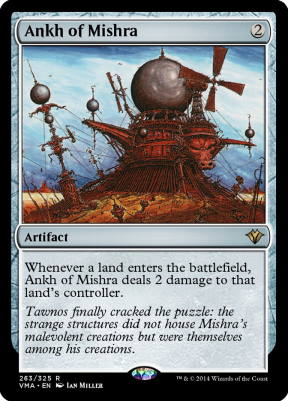
First, try to pressure the green player’s life total. If they spend the first few turns of the game ramping, it’s unlikely they’ll have many blockers. With enough damage, you might force them to make some defensive plays instead of just getting more resources.
Try to convince the other players to chip in, too. You don’t have to bully the green player out of the game: just try to set them back enough to make things even.
Second, there are some cards that directly punish players for playing lands. Ankh of Mishra, Nightshade Harvester, and Zo-Zu the Punisher all hurt your opponents just for playing lands. This option alone often won’t be enough to stop dedicated landfall decks, though.
Not only do they have access to lifegain, such as Tatyova, Benthic Druid or Omnath, Locus of Creation, but these cards could also make you the archenemy. Nobody likes being punished for playing lands, so your other opponents might gang up on you.
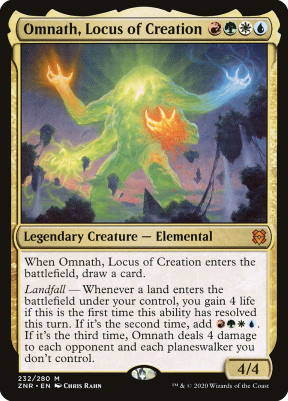
Lastly, counter their big ramp spells. If you choose this option, you’ll likely want to run more counterspells than you otherwise would. Cheap spells like Rampant Growth aren’t usually worth countering, but expensive ramp cards like Thran Dynamo or Awaken the Woods are excellent targets!
RELATED: The Best MTG Counterspells
End Step
One of green’s biggest strengths is its ramp cards, and it has plenty of variety. We’ve gone over why you need ramp, what kind of ramp you should run, and even how to play against ramp. Now, you should be ready to get your engine rolling and set yourself up for success!
